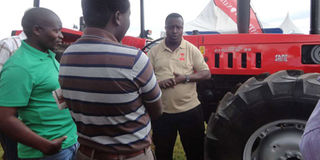Understanding the farm tractor; its many duties

An expert from Simba Corp explains a point on SAME tractors during the past Seeds of Gold Farm Clinic in Kericho. Routine maintenance of the tractor should be carried out to boost its efficiency. PHOTO | BRIAN OKINDA | NATION MEDIA GROUP
What you need to know:
- Tractors are available in a wide range of options to suit specific tasks and requirements.
- The walking tractor is a two-wheel machine designed for those farmers who cannot afford the big machines.
- During harvesting, the tractor is used to haul the produce for storage, to harvest hay and to power mowers, hay rakes and baling machines.
- Modern tractors feature power-shift and hydrostatic transmission to simplify operation.
A tractor is a vehicle designed to give high tractive effort at low speeds for the purposes of hauling agricultural implements.
Tractors are generally classified by the number of axles or wheels, with main categories being two-wheel tractors (single-axle tractors) and four-wheel tractors (two-axle tractors).
Among four-wheel tractors, most are two-wheel drive; but many are two-wheel drive with front wheel assist, four-wheel drive (often with articulated steering), or track tractors (with steel or rubber tracks).
Row crop tractors have adjustable tread width to allow the machine to pass down rows of maize or other crops without crushing the plants.
Standard tractors have fixed wheels and a lower centre of gravity for ploughing and other heavy field work.
High crop tractors have adjustable tread and increased ground clearance, often used in the cultivation of cotton and other high-growing row crop plant operations.
Tractors are available in a wide range of options to suit specific tasks and requirements.
Those in a horsepower range of 15hp to 40hp are ideal for landscaping tasks such as digging, hauling or ploughing on large gardens, fields and pastures and spraying chemicals to crops.
Diesel or utility tractors with a horsepower range of 45hp to 110hp have a low centre of gravity and short turning radius and are used for on-farm grading, landscape maintenance and excavation purposes.
The walking tractor is a two-wheel machine designed for those farmers who cannot afford the big machines.
It has a plough disc for tilling and can also be used to pump water to the farm and to cut animal feeds with a chaff cutter.
TRACTORS' MANY USES
Bush pullers are special tongs that attach to bushes so that they can be pulled out by the roots with the tractor or winch.
The front-end loader is useful for pushing, lifting and carrying brush and logs. For heavy loads, a rear carrier is used because it has more lift capacity and puts the weight on the tractor’s more robust rear axle.
The front end loader of rear lift are used to move rocks and fill dirt and the blade to sculpt the ground, level off hills, direct drainage and build small ponds.
A tractor can be used to reel out rolls of barbed wire, as well as carrying steel posts, post driver, fence stretcher, corner posts, post-hole digger, iron bar and shovel.
A steel rod mounted on the back of the trailer serves as a spindle for rolling out the wire as the tractor is driven down the fence line.
Tractors are used in construction projects to drill holes. The backhoe is used to dig foundations, electric and water lines, or move sand and gravel.
The loader equipped with forks are used for unloading building materials, moving sacks of cement, setting rafters or trusses in place, and lifting roofing materials.
During harvesting, the tractor is used to haul the produce for storage, to harvest hay and to power mowers, hay rakes and baling machines.
Specialised equipment like tree shakers for nut trees and potato diggers are also run by tractors.
POWER GENERATOR
The tractor can also serve as a power generator. Connecting a 240-volt inverter to tractor battery can supply power to run saws, drills, lights, computers and communication equipment.
A deep-cycle battery and high-capacity alternator can be incorporated to extend the power output.
Modern tractors feature power-shift and hydrostatic transmission to simplify operation.
While these tractors are also provided with power steering to make turning much easier, advanced models help reduce operator fatigue with exclusive shift controls and an automatically responsive transmission.
Global Positioning Systems (GPS) devices and robust on-board computers are installed as optional features on advanced farm tractors used in modern, precision farming techniques.
Routine maintenance of tractor is carried out to boost its efficiency. The brakes should be lubricated and adjusted. It should be kept clean so that it’s easy to spot damaged components and leaks.
Oil, fuel and water levels should be checked daily. Additionally, loose nuts should be tightened and tire pressure checked regularly.
Prof Nyaanga and Otieno, Faculty of Engineering, Egerton University.




